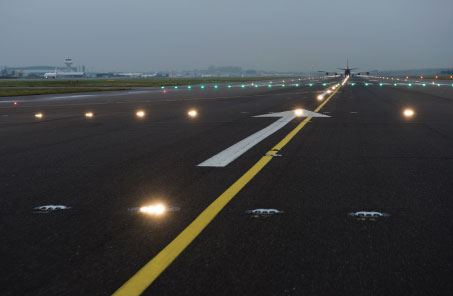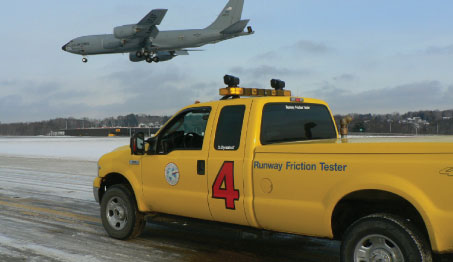
ICAO Circular 329 has been developed to establish a conceptual understanding of the friction issues and recommends a holistic approach to the reporting of the pavement surface friction characteristics.
ICAO Circular 329 has been developed to establish a conceptual understanding of the friction issues and recommends a holistic approach to the reporting of the pavement surface friction characteristics, as well as providing a basis for future improvement in the larger remit of assessing and reporting of runway surface conditions.
“The Task Force proposed a number of amendments to the existing high-level Standards and Recommended Practices (SARPs) in several ICAO Annexes related to runway surface friction and contaminants,” Cheong explained.

Operational friction testing can be performed during such adverse weather as heavy rain, ice, slush or snow, with data reporting in both metric and US units.
Dynatest’s friction solution
The Dynatest 6875 Runway Friction Tester (RFT) is designed for both functional (maintenance) and operational testing to evaluate surface friction changes.
Operational friction testing can be performed during such adverse weather as heavy rain, ice, slush or snow, with data reporting in both metric and US units. The 6875 meets all of the FAA and ICAO specifications for friction measuring devices (CFME).
The RFT includes the industry’s largest 1,000 litre (250 U.S. gallon) built in, aluminium, baffled water tank, positive displacement water pump and ASTM laminar flow water nozzle for self wetting testing of up to 11,000m+ (36,000ft+) of runway without refilling. Larger water tank sizes are available on request. For airports in winter environments, the RFT comes with four-wheel drive. The test gear in the RFT does not require changing the vehicle manufacturer’s axles and preserves the factory warranty.
“These pertain to, among others, the promulgation of aerodrome data on the condition of the runway for flight operation purposes, new and amended friction-related provisions concerning design and maintenance of pavements, including a new section on the timely removal of contaminants. Also included are proposed changes to the ICAO SNOWTAM format and ATC (Air Traffic Control) phraseologies with respect to runway surface conditions and aircraft braking action. These proposals are being processed in accordance with established procedures.”
As the Task Force seeks to harmonise runway friction standards as far as possible, it will closely monitor the work of the EASA (European Aviation Safety Agency) Runway Friction Characteristics Measurement and Aircraft Braking (RuFAB) project. The results of other regional initiatives, such as the US FAA (Federal Aviation Administration) Takeoff and Landing Performance Assessment – Aviation Rulemaking Committee (TALPA-ARC) project, will also be considered when developing global provisions for use in the 190 Contracting States of ICAO.
“The Task Force will continue to develop and harmonise worldwide provisions and procedures for the assessment and reporting of runway surface conditions, including a standard reporting format and taxonomy,” Cheong said. “There is an urgent need to report runway state conditions in a standardised manner that will enable flight crews to use this information to determine, as accurately as possible, aircraft performance for takeoff and landing. Runway condition reporting should use terminologies and values that can be utilised in conjunction with the aircraft performance charts supplied by the manufacturers. This commonality of terminologies and values is designed for use by the various stakeholders in the value chain.”
These stakeholders include the aircraft manufacturers who develop the performance tables; the aerodromes personnel who evaluate and report the runway conditions; the air traffic controllers and aeronautical information specialists who transmit the data; and the pilots and flight operations officers/flight dispatchers who apply the data.
Common understanding
 While the work of the Task Force, as well as that of the likes of EASA and the FAA, has already laid the foundations for a harmonised approach to runway friction standards, Cheong explained that there is still work to be done. For instance, there is a pressing need, he said, to develop the necessary tools required for the reduction of runway excursion risk factors associated with surface contamination.
While the work of the Task Force, as well as that of the likes of EASA and the FAA, has already laid the foundations for a harmonised approach to runway friction standards, Cheong explained that there is still work to be done. For instance, there is a pressing need, he said, to develop the necessary tools required for the reduction of runway excursion risk factors associated with surface contamination.
IFPA informs and educates on friction testing
The International Friction Pavement Association (IFPA) is the leading membership organisation for individuals whose primary business involves the development and standardisation of friction pavement evaluations and techniques. Established in 2006, IFPA serves as a community that connects members internationally, providing valuable information, education and resources to its members.
IFPA conducts field testing on its Thomas J. Yager Research and Test Facility, a 1,500-foot runway located at the Hernando County Airport Industrial Park in Brooksville, Florida. IFPA researches the varying friction properties of the pavement types on its track and shares its findings with the agencies so they may be considered in future airport runway safety standards. IFPA certifies individuals as ‘Airport Safety Inspectors’ who successfully complete a three-day friction programme and evaluation.
“The science of measuring, assessing and reporting runway surface friction characteristics, and to its wider remit of surface contamination, is often fraught with uncertainties,” he said. “Hitherto, there are no internationally agreed methods to assess the runway surface friction characteristics under all conditions and to correlate such results to the operational aircraft braking performance. There are inherent weaknesses in existing reporting formats as means of transmitting safety critical information to pilots. Therefore, there is a need for a common understanding of the definitions and processes related to reporting, including the development of a global reporting format using standardised terms for operational purposes.”
ASFT Weather System
 Every day millions of people in 52 countries around the world lead a safer life on the road or at the airport due to ASFT products.
Every day millions of people in 52 countries around the world lead a safer life on the road or at the airport due to ASFT products.
Sweden-based ASFT is a leading developer and manufacturer of Continuous Friction Measuring Equipment (CFME), and provider of cutting-edge ITS and Road/Runway Weather Information System (RWIS).
ASFT develops and provides IT systems and products for surveying surface and weather-condition at airports. The products include computerised technology for monitoring factors such as friction, freezing points, early ice warning-systems, precipitation, ground frost, ice deposit growth, and camera-surveillance systems among others.
The objective for measuring friction and other variables is to serve as a basis for decisions in order to make the correct maintenance and operational assessments at the right time and place. The ultimate objective is to achieve acceptable road or runway conditions for vehicles to travel safely.
The technology is purpose built for stationary or mobile use. Fixed information systems provide continuous sampling of values and monitoring of changes over time; vehicle-mounted sensors provide a mobile information centre to have complete coverage of an entire infrastructure to sense factors such as friction, atmospheric conditions, pavement temperature, surface condition, surface freezing point etc.; and the mobile system provides real-time data for maintenance and operational decisions and supplements information from fixed information systems.
Findlay Irvine supplies 500th GripTester
Four new GripTester machines, designed and manufactured by Findlay Irvine Ltd., will be making road surfaces in Scotland safer, more durable and less prone to maintenance roadworks.
The new GripTester machines automatically measure the ‘grip’ of the road surface, collate the data and provide it in clear, graphic reports and displays. They follow the same design principals as those used on airport runways worldwide – where an accident can have catastrophic consequences.
The new GripTesters – numbers 500 to 503 – will be operated by contractors looking after the four highways regions of Scotland.
Findlay Irvine Managing Director Colin Findlay said: “It has been estimated that each fatal accident on our roads can cost about £1.5 million – and that’s not taking into account all the emotional trauma. By checking on the skid risk, and taking remedial action, Scotland’s roads will be significantly safer.”
Findlay Irvine has been developing GripTesters for all surfaces for more than
 25 years for airports and highways. On airport runways they are able to assess the effects of rubber building up on the surface after aircraft land and take-off, which creates a dangerous risk of planes skidding off the runway when wet if not removed.
25 years for airports and highways. On airport runways they are able to assess the effects of rubber building up on the surface after aircraft land and take-off, which creates a dangerous risk of planes skidding off the runway when wet if not removed.







